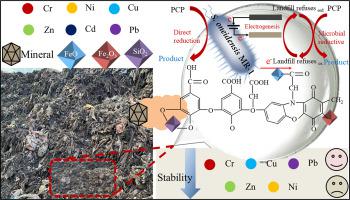Science of the Total Environment ( IF 9.8 ) Pub Date : 2020-12-04 , DOI: 10.1016/j.scitotenv.2020.144122 Hong-Bao Liu , Si-Jia Liu , Xiao-Song He , Fei Dang , Yuan-Yuan Tang , Bei-Dou Xi

|
Landfill refuse is a mixture of inorganic minerals and organic matter that is capable of undergoing complexation and redox reactions due to its active functional groups. Organic matter often combines with minerals in landfill refuse and it remains unclear whether this combination involves electron transfer. Therefore, the effects of landfill refuse composition on reductive dechlorination and speciation transformation of heavy metals were investigated in this study. Results show that landfill refuse comprises protein- and humic-like substances, aliphatic structures, and a large number of hydroxyl, carboxyl, quinoid and other active functional group. The electron donating capacity (0.09–0.26 μmol/g(C)) of landfill refuse was found to be higher than its electron accepting capacity (0.03–0.23 μmol/g(C)), indicating that electron donating groups (hydroxyl) were the main redox-active moieties, facilitating the reductive dechlorination of pentachlorophenol (PCP) by microorganism. Fe2O3, FeO and SiO2 were the main inorganic minerals affecting PCP dechlorination. The speciation distribution of heavy metals in landfill refuse was determined by the BCR sequential extraction method. Results showed that Zn and Ni have high potential migration capacity, poor stability and the highest bioavailability, while Cr, Cu and Pb are relatively stable and have weak migration potential. The oxygen- and nitrogen-containing functional groups, aliphatic structures and aromatic carbon in landfill refuse can promote the transformation of Ni and Cr from an unstable to stable state. Protein-like substances exhibit a strong Cu binding ability, allowing Cu to combine with organic matter more easily than other assessed heavy metals. Both Fe2O3 and FeO affected the stability of Cu. FeO promoted the stabilization of Zn, whereas Fe2O3 and SiO2 promoted Cu instability. These results could provide some references for the treatment of organic chlorides and the stabilization of heavy metals in landfill refuse in China.
中文翻译:

垃圾填埋场对五氯苯酚还原脱氯及重金属形态转化的影响
垃圾填埋场是无机矿物和有机物质的混合物,由于其活性官能团而能够进行络合和氧化还原反应。有机物经常与垃圾填埋场中的矿物质结合,目前尚不清楚这种结合是否涉及电子转移。因此,本研究研究了垃圾填埋场垃圾成分对还原性脱氯和重金属形态转化的影响。结果表明,垃圾填埋场包含蛋白质和腐殖质样物质,脂肪族结构以及大量的羟基,羧基,醌型和其他活性官能团。发现垃圾填埋场的给电子能力(0.09–0.26μmol/ g(C))高于其电子接受能力(0.03–0.23μmol/ g(C)),表明给电子基团(羟基)是主要的氧化还原活性部分,促进了微生物对五氯苯酚(PCP)的还原脱氯作用。铁2 O 3,FeO和SiO 2是影响PCP脱氯的主要无机矿物。垃圾填埋场垃圾中重金属的形态分布通过BCR连续提取法确定。结果表明,Zn和Ni具有较高的潜在迁移能力,稳定性较差,生物利用度最高,而Cr,Cu和Pb相对稳定且迁移潜力较弱。垃圾填埋场中的含氧和氮官能团,脂肪族结构和芳族碳可以促进Ni和Cr从不稳定状态转变为稳定状态。类蛋白质物质具有很强的Cu结合能力,与其他评估的重金属相比,Cu更容易与有机物结合。既有Fe 2 O3和FeO影响Cu的稳定性。FeO促进了Zn的稳定,而Fe 2 O 3和SiO 2促进了Cu的不稳定性。这些结果可为我国垃圾掩埋场中有机氯化物的处理和重金属的稳定化提供参考。



























 京公网安备 11010802027423号
京公网安备 11010802027423号